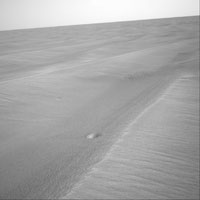

With the major Apollo development effort winding down in the second half of the 1960s, NASA started looking to the future of the space program. They envisioned an ambitious program consisting of a large space station being launched on huge boosters, served by a reusable logistics "space shuttle", both providing services for a permanantly manned Lunar colony and eventual manned missions to Mars.
Space Shuttle Atlantis
Space Shuttle Atlantis Shuttle Orbiter Atlantis (NASA Designation: OV-104) In its most recent flight, Atlantis and her six-person crew completed an eleven-day mission in October 2002 to the International Space Station that involved three space walks. Table of contents showTocToggle("show","hide") 1 Flights 2 Related articles 3
Image Below form NASA: Tiny Craters on Meridiani Planum These two craters, each smaller than a foot in diameter and less than one-half inch deep, were found intact by NASA's Mars rover Opportunity. Image credit: NASA/JPL

Hubble Space Telescope
Hubble Space Telescope The Hubble Space Telescope (HST, or Hubble) is a telescope located at the outer edges of Earth's atmosphere, about 600 kilometerss above the ground, orbiting the Earth every 100 minutes. It was placed into orbit, in April 1990, as a joint project of NASA and the ESA. The telescope can achieve optical resolutions greater than 0.1 arcseconds. The HST is named after Edwin Hubble. It is scheduled for replacement, by the James Webb Space Telescope (JWST), in 2009. Every day, the Hubble Space Telescope archives 3 to 5 gigabytes of data and delivers between 10 and 15 gigabytes to astronomers. Working outside the atmosphere has advantages because the atmosphere obscures images and filters out electromagnetic radiation at certain wavelengths, mainly in the infrared. Hubble
John F. Kennedy Space Center
John F. Kennedy Space Center The John F. Kennedy Space Center (KSC) is the NASA space vehicle launch facility (spaceport) at Cape Canaveral on Merritt Island in Florida, United States. The site is midway between Miami and Jacksonville, Florida. It is 55 km long and around 10 km wide, covering 56,700 hectares. Around 17,000 people work at the site. There is a visitor center and public tours and KSC is a major tourist destination for visitors to Florida. Because much of KSC is off limits to development, the site also serves as an important wildlife sanctuary. Operations are currently controlled from Launch Complex 39, the location of the Vehicle Assembly Building. 6 km to the east of the assembly building are the two launch pads. 8 km south
Ulysses (spacecraft)
for the Latin translation of Odysseus) was launched in October 1990 from the Space Shuttle Discovery (mission STS-41) as a joint venture of NASA and the European Space Agency. The spacecraft first flew to Jupiter for a swing-by maneuver which brought it out of the ecliptic plane, in order to investigate the polar regions of the sun. It did explore both the northern and southern solar pole, which gave many unexpected result. Especially the southern magnetic pole was found to be much more dynamical and without any fixed clear magnetic pole. The short version "The sun has no magnetic south pole" is misleading, as the sun is not a magnetic monopole. Ulysses' mission is extended until at least 2004.
Meanwhile the Air Force had a continuing interest in smaller systems with more rapid turn-around times, and were involved in their own spaceplane project called Dynasoar. In several instances groups from both worked together to investigate the state of the art.
Kalpana Chawla
(July 1, 1961 - February 1, 2003) was an astronaut and space shuttle mission specialist of STS-107 (Columbia) who was killed when the craft disintegrated after reentry into the Earth's atmosphere. Kalpana Chawla Table of contents showTocToggle("show","hide") 1 Early Life 2 Education 3 NASA Career 4 Personal Characteristics 5 Memoria 6 See also 7 External Links Early Life Chawla was born in Karnal, Haryana, India. Her interest in flight was inspired by J. R. D. Tata, India's first pilot. Education Chawla studied aeronautical engineering at the Punjab Engineering College in Punjab, India in 1982 where she earned her Bachelor of Science degree. Thereafter she moved to the United States to obtain a Master of Science degree in aerospace engineering from University of Texas (1984). Dr. Chawla earned a doctorate in aerospace